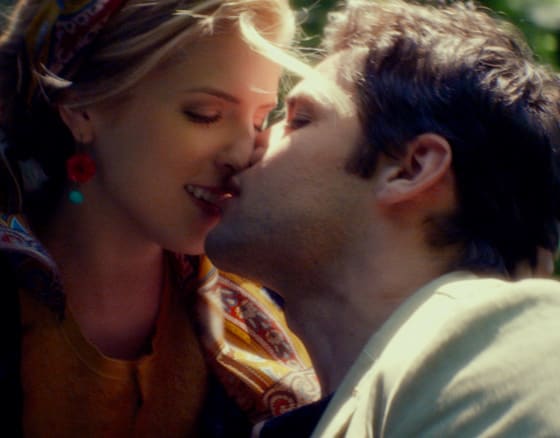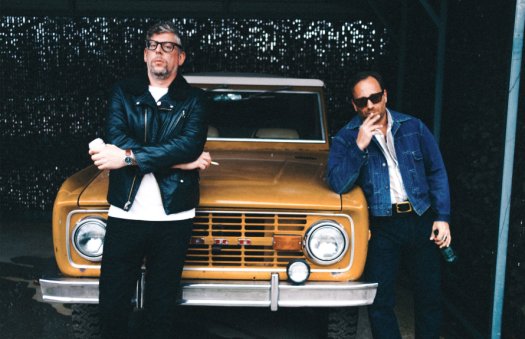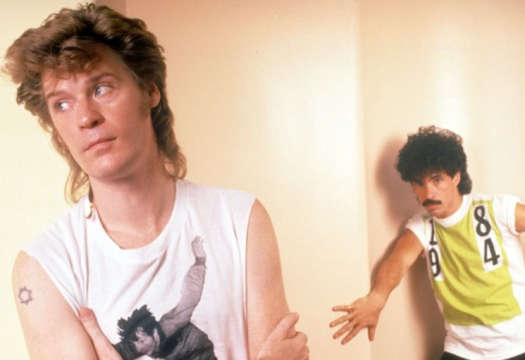The Last Five Years feels like the movie Anna Kendrick's been building to for a while now, and it's is a big step in the right direction for the multitalented actress who got her start on Broadway before moving to genre fare like Twilight and Scott Pilgrim. If 2012's Pitch Perfect proved Kendrick could make her musical chops work onscreen, (something easier said than done for many Broadway actors), it still felt underwhelming to see her in the straight-woman role opposite that film's scene stealer, Rebel Wilson. In between Pitch Perfect and The Last Five Years, Kendrick has adopted a welcome naturalism to her performances, most likely thanks to her improv work with mumblecore godfather Joe Swanberg in Drinking Buddies and Happy Christmas. And while she got to sing again in last December's Into The Woods, that film was yet another Rob Marshall vehicle where he undercut every cinematic moment for something bafflingly claustrophobic, ruining a lot of good performances like Kendrick's in its wake.
So consider The Last Five Years as Anna Kendrick's big reveal, her laying all the cards on the table moment. Not only can she sing and act, but she can sing and act at the same time, coupled with complicated choreography, somehow pulling off a lived-in naturalism (usually a big no-no in these sorts of musicals) that sells the heightened emotion of the music at the same time. It's an intriguing balancing act that opens itself up to a whole lot of scrutiny thanks to the longer takes and swooping camera work of DP Steven Meizler. LaGravenese succeeds in making Jason Robert Brown's chamber drama musical feel genuinely cinematic, thanks to a gorgeous widescreen frame and intricate blocking that could only be pulled off by pros like Kendrick and her co-lead Jeremy Jordan.
The film follows the story of the musical, taking a five-year relationship and trying to make sense of how love develops and fades away. Starting at the end, Cathy (Kendrick) makes her way backwards through the relationship with each scene happening in reverse order, while Jamie (Jordan) moves through his scenes in chronological order. Onstage, this conceit worked well as the production was basically a two-person show; Cathy would be alone in a solo performance for her scenes while Jamie would be alone for his. The two meet in the middle and share their only scene, just before the curtain drops on the first act, as Cathy and Jamie marry in Central Park. LaGravenese ditches these stagy trappings for something much more conventional, something the film struggles with figuring out how to pull off. In this adaptation, both characters appear in each other's scenes, but only one person does most of the singing each time around. LaGravenese sells the emotion and energy of the music with a natural, classical touch that works wonders for the transition from stage to screen, but struggles in expressing this complicated narrative structure. With a Sondheim-esque all-singing-all-the-time approach, it can be difficult to make sense of where one is chronologically in the story, and the complicated structure deserves a sturdier directorial approach.
As with the stage production, the music is terrific and memorable — a difficult thing to pull off in the modern-day musical. While Kendrick relishes the opportunity to finally engage with a nuanced character, Jordan struggles with selling the complications his character faces in the second half of the film. As Cathy and Jamie head into the later parts of their relationship, Jamie finds huge success as a writer while Cathy can't seem to catch a break in her acting career. Here, The Last Five Years loses focus and can't seem to connect with these characters, as Jamie faces cliché after cliché, and the central conflict ends up becoming a staid question: "Will Jamie cheat on Cathy?"
If the film ends up being eye-rollingly trite in its final act, LaGravenese still manages to imbue it all with a sense of charming naivety, as the young artists struggle with financial and creative burdens that don't resemble anything close to reality. But, ultimately, selling a fantasy is the point of musicals, and LaGravenese directs with every bit of energy and excitement the film can muster. If this is what the "indie musical" looks like in 2015 (and the film was made on a small budget, despite its big ambitions), the genre is in a good place.
(eOne)So consider The Last Five Years as Anna Kendrick's big reveal, her laying all the cards on the table moment. Not only can she sing and act, but she can sing and act at the same time, coupled with complicated choreography, somehow pulling off a lived-in naturalism (usually a big no-no in these sorts of musicals) that sells the heightened emotion of the music at the same time. It's an intriguing balancing act that opens itself up to a whole lot of scrutiny thanks to the longer takes and swooping camera work of DP Steven Meizler. LaGravenese succeeds in making Jason Robert Brown's chamber drama musical feel genuinely cinematic, thanks to a gorgeous widescreen frame and intricate blocking that could only be pulled off by pros like Kendrick and her co-lead Jeremy Jordan.
The film follows the story of the musical, taking a five-year relationship and trying to make sense of how love develops and fades away. Starting at the end, Cathy (Kendrick) makes her way backwards through the relationship with each scene happening in reverse order, while Jamie (Jordan) moves through his scenes in chronological order. Onstage, this conceit worked well as the production was basically a two-person show; Cathy would be alone in a solo performance for her scenes while Jamie would be alone for his. The two meet in the middle and share their only scene, just before the curtain drops on the first act, as Cathy and Jamie marry in Central Park. LaGravenese ditches these stagy trappings for something much more conventional, something the film struggles with figuring out how to pull off. In this adaptation, both characters appear in each other's scenes, but only one person does most of the singing each time around. LaGravenese sells the emotion and energy of the music with a natural, classical touch that works wonders for the transition from stage to screen, but struggles in expressing this complicated narrative structure. With a Sondheim-esque all-singing-all-the-time approach, it can be difficult to make sense of where one is chronologically in the story, and the complicated structure deserves a sturdier directorial approach.
As with the stage production, the music is terrific and memorable — a difficult thing to pull off in the modern-day musical. While Kendrick relishes the opportunity to finally engage with a nuanced character, Jordan struggles with selling the complications his character faces in the second half of the film. As Cathy and Jamie head into the later parts of their relationship, Jamie finds huge success as a writer while Cathy can't seem to catch a break in her acting career. Here, The Last Five Years loses focus and can't seem to connect with these characters, as Jamie faces cliché after cliché, and the central conflict ends up becoming a staid question: "Will Jamie cheat on Cathy?"
If the film ends up being eye-rollingly trite in its final act, LaGravenese still manages to imbue it all with a sense of charming naivety, as the young artists struggle with financial and creative burdens that don't resemble anything close to reality. But, ultimately, selling a fantasy is the point of musicals, and LaGravenese directs with every bit of energy and excitement the film can muster. If this is what the "indie musical" looks like in 2015 (and the film was made on a small budget, despite its big ambitions), the genre is in a good place.




